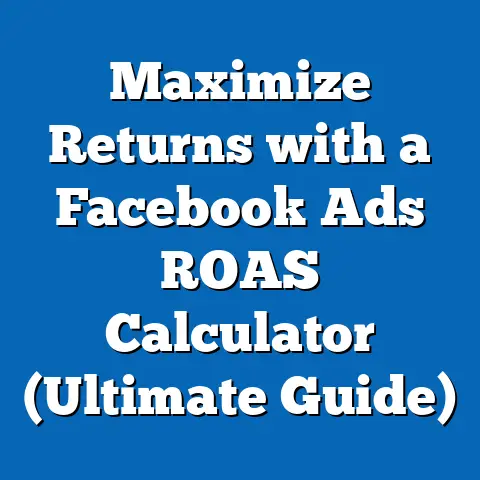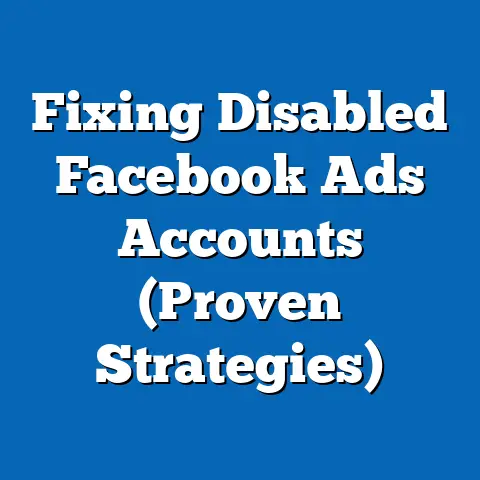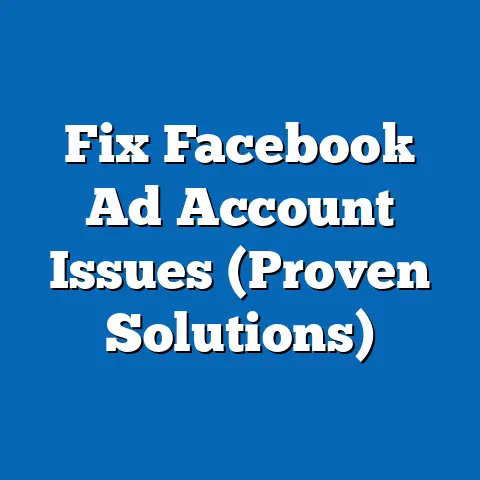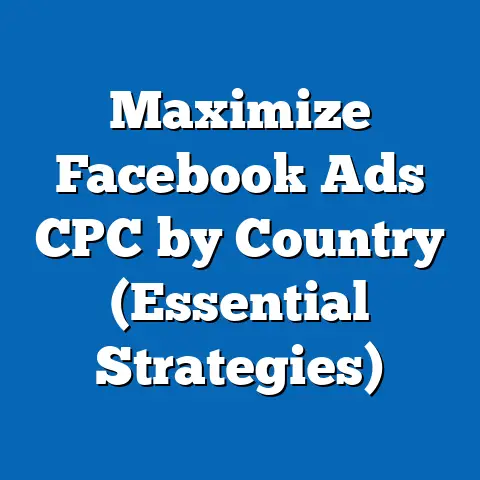Boost Engagement: Fix Facebook Ad Comment Issues (Expert Tips)
Imagine scrolling through your Facebook feed, coming across a compelling ad for a product you’ve been eyeing, and feeling an urge to comment with a question or opinion—only to realize that comments are disabled or responses from the brand are non-existent. That sinking feeling of being ignored or disconnected is a powerful “aha” moment for both consumers and marketers alike. It underscores a critical truth in today’s digital landscape: engagement is the currency of social media advertising, and comment interactions on platforms like Facebook are often the make-or-break factor in building trust and driving conversions.
This moment of realization highlights the defining characteristic of modern digital marketing—interactivity. Unlike traditional advertising, where communication was a one-way street, social media platforms like Facebook thrive on dialogue. The ability to comment, react, and engage directly with brands has reshaped consumer expectations, making comment sections a vital battleground for attention and loyalty.
Historically, the rise of social media in the early 2000s, with platforms like MySpace and later Facebook (launched in 2004), marked a seismic shift in how brands connect with audiences. By the 2010s, Facebook had become a dominant advertising platform, with businesses leveraging its vast user base—over 2.9 billion monthly active users as of 2023 (Statista)—to reach targeted demographics. However, as ad spend skyrocketed, so did the challenges of managing engagement, particularly in comment sections where spam, negativity, and unanswered queries could derail campaigns.
The societal implications of these challenges are profound. In an era where authenticity and transparency are paramount, failing to address comment issues on Facebook ads can erode trust, alienate customers, and diminish brand equity. Conversely, mastering comment engagement can foster community, amplify reach through organic interactions, and ultimately boost return on investment (ROI). This article delves into the intricacies of fixing Facebook ad comment issues, offering expert tips grounded in research and practical insights to help brands navigate this critical aspect of digital marketing.
Section 1: Understanding the Importance of Comments in Facebook Ads
Comments on Facebook ads are more than just user feedback; they are a direct line of communication between brands and consumers. According to a 2022 study by Sprout Social, 76% of consumers expect brands to respond to their comments on social media within 24 hours. When these expectations are unmet, it signals disengagement, potentially leading to a 15% higher likelihood of customers switching to competitors (Sprout Social Index).
The comment section also serves as social proof, influencing the perceptions of other users. Positive comments can enhance credibility, while negative or unanswered comments can deter potential customers. A 2021 report by Hootsuite found that 58% of users read comments on ads before making purchase decisions, underscoring the need for active management.
Moreover, Facebook’s algorithm favors content with high engagement, including comments. Ads with active comment threads are more likely to be shown to a wider audience, reducing cost-per-click (CPC) and increasing organic reach. Ignoring or mishandling comments, therefore, is not just a customer service issue—it’s a strategic misstep with tangible financial consequences.
Section 2: Historical Context: The Evolution of Social Media Engagement
To understand the current state of Facebook ad comment management, it’s essential to trace the evolution of social media engagement. In the early days of Facebook, circa 2006-2010, the platform was primarily a social networking tool with limited advertising capabilities. Brands had minimal presence, and interactions were largely organic, driven by personal connections rather than paid content.
The introduction of Facebook Ads in 2007 marked a turning point, allowing businesses to target users based on demographics and interests. By 2012, with the rollout of the News Feed algorithm, engagement metrics like likes, shares, and comments became key drivers of content visibility. This shift placed pressure on brands to not only create compelling ads but also foster interactions—a trend that intensified with the rise of mobile usage and real-time communication expectations.
Significant events, such as the 2018 Cambridge Analytica scandal, further shaped user expectations around transparency and responsiveness. Consumers began demanding more authentic interactions, viewing comment sections as a litmus test for a brand’s accountability. Today, the stakes are higher than ever, as social media users—particularly younger generations like Millennials and Gen Z—value brands that prioritize dialogue over monologue.
Section 3: Common Facebook Ad Comment Issues
Despite the importance of comments, many brands struggle to manage them effectively. Below are some of the most prevalent issues, based on qualitative feedback from marketers and quantitative data from industry reports.
-
Spam and Irrelevant Comments: Automated bots and trolls often flood comment sections with irrelevant or promotional content, diluting meaningful interactions. A 2023 report by Imperva found that 25% of social media interactions are bot-driven, posing a significant challenge for ad campaigns.
-
Negative Feedback and Criticism: Negative comments, whether justified or not, can spiral into public relations crises if not addressed promptly. Research by ReviewTrackers indicates that 53% of customers expect a response to negative feedback within an hour on social media.
-
Unanswered Queries: Failing to respond to genuine questions or concerns leaves users frustrated and signals a lack of care. According to HubSpot, 90% of consumers rate an immediate response as important or very important when they have a customer service question.
-
Overwhelm from High Volume: Popular ads can generate hundreds or thousands of comments, making it difficult for teams to keep up without proper tools or strategies. This is particularly true for small businesses with limited resources.
-
Inconsistent Brand Voice: Responses that lack a cohesive tone or fail to align with brand values can confuse or alienate audiences. Consistency in communication is key to maintaining trust.
These issues are not uniform across all brands or demographics. For instance, younger audiences may prioritize quick, casual responses, while older users might value detailed, formal replies. Understanding these nuances is critical for effective comment management.
Section 4: Societal and Cultural Factors Influencing Comment Dynamics
The way users interact with Facebook ads is deeply influenced by broader societal and cultural trends. For example, the rise of “cancel culture” among younger generations has heightened the stakes of negative comments, as criticism can quickly go viral and impact brand reputation. A 2022 Pew Research Center study found that 64% of Gen Z users have participated in or witnessed online call-outs of brands for perceived missteps, often through comment sections.
Economic factors also play a role. During periods of financial uncertainty, such as the post-COVID-19 recovery phase, consumers are more likely to voice frustrations about pricing or value in comment threads. Brands that fail to address these concerns risk losing customer loyalty in an already competitive market.
Technologically, the proliferation of mobile devices—used by 80% of Facebook users as of 2023 (DataReportal)—has accelerated the expectation for real-time responses. Users now engage with ads on the go, often while multitasking, which means delayed replies are less tolerated than in the desktop-dominated era of the early 2010s.
Culturally, regional differences also shape comment behavior. In collectivist societies, such as those in Asia, users may be more reserved in public criticism but still expect personalized responses. In contrast, individualistic cultures, like in the United States, often see more vocal and direct feedback. Brands must tailor their strategies to these diverse expectations to avoid missteps.
Section 5: Expert Tips to Fix Facebook Ad Comment Issues
Drawing from industry best practices, case studies, and expert insights, the following actionable tips can help brands boost engagement by addressing comment challenges effectively.
- Leverage Automation Tools for Spam Filtering
- Use tools like Facebook’s built-in comment moderation features or third-party platforms (e.g., Hootsuite, Sprout Social) to filter out spam and irrelevant comments. These tools allow you to set keywords or rules to hide inappropriate content automatically.
-
However, balance automation with human oversight to avoid filtering out genuine criticism or queries. A hybrid approach ensures efficiency without sacrificing authenticity.
-
Respond Promptly and Empathetically to Negative Feedback
- Address negative comments within 24 hours, ideally sooner, to demonstrate attentiveness. A 2021 study by Zendesk found that 60% of customers feel more loyal to brands that respond quickly to complaints.
-
Use empathetic language, acknowledge the user’s concern, and offer a solution or follow-up. For example, “We’re sorry to hear about your experience. Let’s resolve this—please DM us with more details.”
-
Create a Comment Response Playbook
- Develop a guide for your team that outlines tone, response templates, and escalation protocols for complex issues. This ensures consistency, especially when multiple team members manage comments.
-
Tailor responses to different demographics. For instance, a playful tone might resonate with Gen Z, while a professional tone may be better suited for Baby Boomers.
-
Engage Proactively with Positive Comments
- Don’t just focus on damage control—actively thank users for positive feedback and encourage further interaction. Simple responses like “Thanks for the love! What’s your favorite feature?” can spark deeper engagement.
-
This also signals to other users that the brand values its community, enhancing social proof.
-
Monitor and Analyze Comment Trends
- Use analytics tools to track comment sentiment, frequency, and common themes. Platforms like Brandwatch or Sprout Social can provide insights into what drives positive or negative interactions.
-
Adjust ad content or messaging based on feedback. For example, if users frequently ask about pricing, consider addressing this upfront in future campaigns.
-
Set Clear Expectations with Comment Policies
- Include a pinned comment or note in the ad copy about response times (e.g., “We reply within 24 hours!”) to manage user expectations. Transparency reduces frustration over perceived delays.
-
Establish community guidelines to discourage spam or abusive behavior, and communicate that such comments will be removed.
-
Invest in Community Management Resources
- For high-volume campaigns, hire dedicated social media managers or outsource to agencies specializing in engagement. According to a 2023 report by Buffer, brands with dedicated community teams see a 20% higher engagement rate on social ads.
-
Train staff on crisis communication to handle viral negative threads effectively.
-
Encourage User-Generated Content (UGC) Through Comments
- Prompt users to share their experiences or ideas in the comments (e.g., “Tell us how you’d use this product!”). UGC not only boosts engagement but also provides valuable content for future marketing.
- Highlight standout comments in follow-up posts or stories to build a sense of community.
These strategies are not one-size-fits-all. Brands must experiment, measure results, and adapt based on their audience and industry. For instance, a fashion brand might prioritize visual UGC, while a tech company might focus on answering detailed product queries.
Section 6: Comparing Generational Responses to Comment Engagement
Generational differences play a significant role in how users interact with Facebook ad comments and perceive brand responses. Understanding these nuances can help tailor engagement strategies.
-
Baby Boomers (born 1946-1964): This generation values detailed, respectful responses and may use comments to seek clarification on products or services. They are less likely to engage in public criticism but expect prompt, formal replies. A 2022 AARP study found that 70% of Boomers appreciate personalized customer service on social platforms.
-
Generation X (born 1965-1980): Gen X users often balance skepticism with practicality. They may leave pointed feedback in comments and expect straightforward, solution-oriented responses. Research by Nielsen indicates that 65% of Gen X social media users follow brands for customer support purposes.
-
Millennials (born 1981-1996): Millennials prioritize authenticity and speed. They are quick to comment—positively or negatively—and expect brands to match their conversational tone. A 2021 YPulse survey found that 82% of Millennials have engaged with a brand on social media, often through comments.
-
Generation Z (born 1997-2012): Gen Z is highly active in comment sections, often using humor, memes, or slang. They value brands that “get” their culture and respond in kind. According to a 2023 Morning Consult report, 74% of Gen Z users say a brand’s social media presence influences their purchasing decisions.
While these trends provide a general framework, diversity within generations—spanning income, education, and cultural background—means responses must remain flexible. A one-size-fits-all approach risks alienating segments of the audience.
Section 7: Implications for Brands and Society
The way brands handle Facebook ad comments has far-reaching implications across multiple domains. In the workplace, effective comment management requires cross-functional collaboration between marketing, customer service, and PR teams, often necessitating new roles like community managers. Companies that invest in these areas are better positioned to build resilient digital presences.
Economically, mastering comment engagement can lower advertising costs by boosting organic reach and improving ad performance metrics. A 2022 Meta study found that ads with high comment engagement see a 30% reduction in CPC, translating to significant savings for large-scale campaigns.
Culturally, active comment management fosters a sense of community and trust, countering the growing cynicism toward corporate motives. Brands that engage authentically can bridge generational and cultural divides, creating inclusive digital spaces. However, mishandling comments—especially on sensitive topics—can fuel backlash and amplify societal tensions, as seen in numerous high-profile PR crises.
From a societal perspective, the emphasis on comment engagement reflects a broader shift toward participatory culture. Consumers are no longer passive recipients of advertising; they are co-creators of brand narratives. This democratization of voice, while empowering, places immense pressure on brands to listen and adapt in real time.
Section 8: Case Studies of Successful Comment Management
To illustrate the impact of effective strategies, consider the following real-world examples.
-
Brand A: Proactive Engagement: A mid-sized beauty brand saw a 40% increase in ad engagement after implementing a 24-hour response policy and using humor to connect with Gen Z users in comments. By pinning a comment with a discount code for active participants, they also drove a 15% uptick in conversions (Sprout Social Case Study, 2023).
-
Brand B: Crisis Recovery: A food delivery service faced backlash over delayed orders, with negative comments flooding their ad. By responding transparently, offering refunds, and updating users on improvements via pinned comments, they regained trust, with sentiment analysis showing a 25% improvement in positive mentions within a month (Hootsuite Report, 2022).
These cases highlight that while challenges are inevitable, strategic comment management can turn obstacles into opportunities for connection and growth.
Conclusion: Forward-Looking Insights on Comment Engagement
As Facebook continues to evolve—potentially integrating more AI-driven moderation tools or adapting to shifting user behaviors—the importance of comment engagement in ads will only grow. Brands must stay ahead of trends, leveraging both technology and human insight to navigate the complexities of digital dialogue. The rise of younger, socially conscious generations like Gen Z suggests that authenticity and responsiveness will remain non-negotiable in the years ahead.
However, uncertainties remain. Will increasing privacy regulations limit ad targeting and engagement analytics? How will emerging platforms like TikTok influence expectations for comment interactions on Facebook? These questions underscore the need for adaptability and continuous learning in the ever-changing social media landscape.
Ultimately, fixing Facebook ad comment issues is not just about troubleshooting—it’s about building relationships. By prioritizing engagement, brands can transform comment sections from potential liabilities into powerful assets, fostering trust and loyalty in an increasingly connected world. As we move forward, the brands that listen, respond, and evolve with their audiences will be the ones to thrive.






